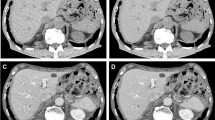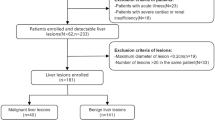Abstract
Objectives
To evaluate the usefulness of deep learning image reconstruction (DLIR) to improve the image quality of dual-energy computed tomography (DECT) of the abdomen, compared to hybrid iterative reconstruction (IR).
Methods
This study included 40 patients who underwent contrast-enhanced DECT of the abdomen. Virtual monochromatic 40-, 50-, and 70-keV and iodine density images were reconstructed using three reconstruction algorithms, including hybrid IR (ASiR-V50%) and DLIR (TrueFidelity) at medium- and high-strength level (DLIR-M and DLIR-H, respectively). The standard deviation of attenuation in liver parenchyma was measured as image noise. The contrast-to-noise ratio (CNR) for the portal vein on portal venous phase CT was calculated. The vessel conspicuity and overall image quality were graded on a 5-point scale ranging from 1 (poor) to 5 (excellent). The comparative scale of lesion conspicuity in 47 abdominal solid lesions was evaluated on a 5-point scale ranging from 0 (best) to −4 (markedly inferior).
Results
The image noise of virtual monochromatic 40-, 50 -, and 70-keV and iodine density images was significantly decreased by DLIR compared to hybrid IR (p < 0.0001). The CNR was significantly higher in DLIR-H and DLIR-M than in hybrid IR (p < 0.0001). The vessel conspicuity and overall image quality scores were also significantly greater in DLIR-H and DLIR-M than in hybrid IR (p < 0.05). The lesion conspicuity scores for DLIR-M and DLIR-H were significantly higher than those for hybrid IR in the virtual monochromatic image of all energy levels (p ≤ 0.001).
Conclusions
DLIR improves vessel conspicuity, CNR, and lesion conspicuity of virtual monochromatic and iodine density images in abdominal contrast-enhanced DECT, compared to hybrid IR.
Key Points
• Deep learning image reconstruction (DLIR) is useful for reducing image noise and improving the CNR of visual monochromatic 40-, 50-, and 70-keV images in dual-energy CT.
• DLIR can improve lesion conspicuity of abdominal solid lesions on virtual monochromatic images compared to hybrid iterative reconstruction.
• DLIR can also be applied to iodine density maps and significantly improves their image quality.






Similar content being viewed by others
Abbreviations
- CNR:
-
Contrast-to-noise ratio
- CT:
-
Computed tomography
- CTDIvol:
-
Computed tomography dose index
- DCNN:
-
Deep convolutional neural networks
- DECT:
-
Dual-energy computed tomography
- DLIR:
-
Deep learning image reconstruction
- DLIR-H:
-
Deep learning image reconstruction at high-strength level
- DLIR-M:
-
Deep learning image reconstruction at medium-strength level
- DLP:
-
Dose-length product
- IQR:
-
Interquartile range
- IR:
-
Iterative reconstruction
- MBIR:
-
Model-based iterative reconstruction
- ROIs:
-
Regions of interest
- SD:
-
Standard deviation
- SNR:
-
Signal-to-noise ratio
- VMI:
-
Virtual monochromatic image
References
McCollough CH, Leng S, Yu L, Fletcher JG (2015) Dual- and multi-energy CT: principles, technical approaches, and clinical applications. Radiology 276:637–653
Kamps SE, Otjen JP, Stanescu AL, Mileto A, Lee EY, Phillips GS (2020) Dual-energy CT of pediatric abdominal oncology imaging: private tour of new applications of CT technology. AJR Am J Roentgenol 214:967–975
Mileto A, Ananthakrishnan L, Morgan DE, Yeh BM, Marin D, Kambadakone AR (2020) Clinical implementation of dual-energy CT for gastrointestinal imaging. AJR Am J Roentgenol 217:651–663
Bak S, Kim JE, Bae K et al (2020) Quantification of liver extracellular volume using dual-energy CT: utility for prediction of liver-related events in cirrhosis. Eur Radiol 30:5317–5326
Noda Y, Tochigi T, Parakh A, Joseph E, Hahn PF, Kambadakone A (2021) Low keV portal venous phase as a surrogate for pancreatic phase in a pancreatic protocol dual-energy CT: feasibility, image quality, and lesion conspicuity. Eur Radiol 31:6898–6908
Greffier J, Frandon J, Hamard A et al (2020) Impact of iterative reconstructions on image quality and detectability of focal liver lesions in low-energy monochromatic images. Phys Med 77:36–42
Nagayama Y, Tanoue S, Inoue T et al (2020) Dual-layer spectral CT improves image quality of multiphasic pancreas CT in patients with pancreatic ductal adenocarcinoma. Eur Radiol 30:394–403
Yoo J, Lee JM, Yoon JH et al (2021) Comparison of low kVp CT and dual-energy CT for the evaluation of hypervascular hepatocellular carcinoma. Abdom Radiol (NY) 46:3217–3226
Agrawal MD, Oliveira GR, Kalva SP, Pinho DF, Arellano RS, Sahani DV (2016) Prospective comparison of reduced-iodine-dose virtual monochromatic imaging dataset from dual-energy CT angiography with standard-iodine-dose single-energy CT angiography for abdominal aortic aneurysm. AJR Am J Roentgenol 207:W125–W132
Leng S, Yu L, Fletcher JG, McCollough CH (2015) Maximizing iodine contrast-to-noise ratios in abdominal CT imaging through use of energy domain noise reduction and virtual monoenergetic dual-energy CT. Radiology 276:562–570
Albrecht MH, Trommer J, Wichmann JL et al (2016) Comprehensive comparison of virtual monoenergetic and linearly blended reconstruction techniques in third-generation dual-source dual-energy computed tomography angiography of the thorax and abdomen. Invest Radiol 51:582–590
Akagi M, Nakamura Y, Higaki T et al (2019) Deep learning reconstruction improves image quality of abdominal ultra-high-resolution CT. Eur Radiol 29:6163–6171
Jiang Hsieh EL, Nett B, Tang J, Thibault J-B, Sahney S (2019) A new era of image reconstruction: TrueFidelity™ - technical white paper on deep learning image reconstruction. https://www.gehealthcarecom/−/jssmedia/040dd213fa89463287155151fdb01922pdf
Jensen CT, Liu X, Tamm EP et al (2020) Image quality assessment of abdominal CT by use of new deep learning image reconstruction: initial experience. AJR Am J Roentgenol 215:1–8
Ichikawa Y, Kanii Y, Yamazaki A et al (2021) Deep learning image reconstruction for improvement of image quality of abdominal computed tomography: comparison with hybrid iterative reconstruction. Jpn J Radiol 39:598–604
Kaga T, Noda Y, Fujimoto K et al (2021) Deep-learning-based image reconstruction in dynamic contrast-enhanced abdominal CT: image quality and lesion detection among reconstruction strength levels. Clin Radiol 76:710.e15–710.e24
American Association of Physicists in Medicine (2008) The measurement, reporting, and management of radiation dose in CT: report of AAPM Task Group 23 of the Diagnostic Imaging Council CT Committee. AAPM report no. 96. College Park (MD): American Association of Physicists in Medicine. https://www.aapm.org/pubs/reports/RPT_96.pdf
Benz DC, Benetos G, Rampidis G et al (2020) Validation of deep-learning image reconstruction for coronary computed tomography angiography: impact on noise, image quality and diagnostic accuracy. J Cardiovasc Comput Tomogr 14:444–451
Kim I, Kang H, Yoon HJ, Chung BM, Shin NY (2020) Deep learning-based image reconstruction for brain CT: improved image quality compared with adaptive statistical iterative reconstruction-Veo (ASIR-V). Neuroradiology 63:905–912
Park C, Choo KS, Jung Y, Jeong HS, Hwang JY, Yun MS (2021) CT iterative vs deep learning reconstruction: comparison of noise and sharpness. Eur Radiol 31:3156–3164
Jacobsen MC, Schellingerhout D, Wood CA et al (2018) Intermanufacturer comparison of dual-energy CT iodine quantification and monochromatic attenuation: a phantom study. Radiology 287:224–234
Gordic S, Puippe GD, Krauss B et al (2016) Correlation between dual-energy and perfusion CT in patients with hepatocellular carcinoma. Radiology 280:78–87
Pfeiffer D, Parakh A, Patino M, Kambadakone A, Rummeny EJ, Sahani DV (2018) Iodine material density images in dual-energy CT: quantification of contrast uptake and washout in HCC. Abdom Radiol (NY) 43:3317–3323
Lin XZ, Wu ZY, Tao R et al (2012) Dual energy spectral CT imaging of insulinoma-value in preoperative diagnosis compared with conventional multi-detector CT. Eur J Radiol 81:2487–2494
Funding
The authors state that this work has not received any funding.
Author information
Authors and Affiliations
Corresponding author
Ethics declarations
The authors declare that this study was conducted according to the principles of the Declaration of Helsinki.
Guarantor
The scientific guarantor of this publication is Dr. Hajime Sakuma (professor, Department of Radiology, Mie University Hospital, Japan).
Conflict of interest
The authors of this manuscript declare no relationships with any companies whose products or services may be related to the subject matter of the article.
Statistics and biometry
No complex statistical methods were necessary for this paper.
Informed consent
Written informed consent was waived by the Institutional Review Board since this study used existing clinical CT image data. The opportunity to opt out of the inclusion to this study was given through a notice in the hospital website. No patient showed intention for an exclusion from this study.
Ethical approval
This study was approved by the Institutional Review Board of Mie University Hospital (Approval number: H2019-207).
Methodology
• retrospective study
• performed at a single center
• diagnostic or prognostic study
Additional information
Publisher’s note
Springer Nature remains neutral with regard to jurisdictional claims in published maps and institutional affiliations.
Supplementary information
ESM 1
(DOCX 15 kb)
Rights and permissions
About this article
Cite this article
Sato, M., Ichikawa, Y., Domae, K. et al. Deep learning image reconstruction for improving image quality of contrast-enhanced dual-energy CT in abdomen. Eur Radiol 32, 5499–5507 (2022). https://doi.org/10.1007/s00330-022-08647-0
Received:
Revised:
Accepted:
Published:
Issue Date:
DOI: https://doi.org/10.1007/s00330-022-08647-0




